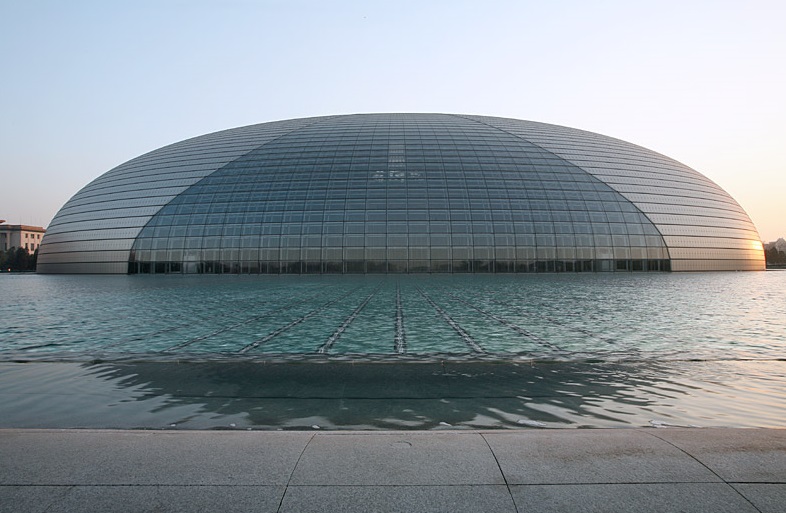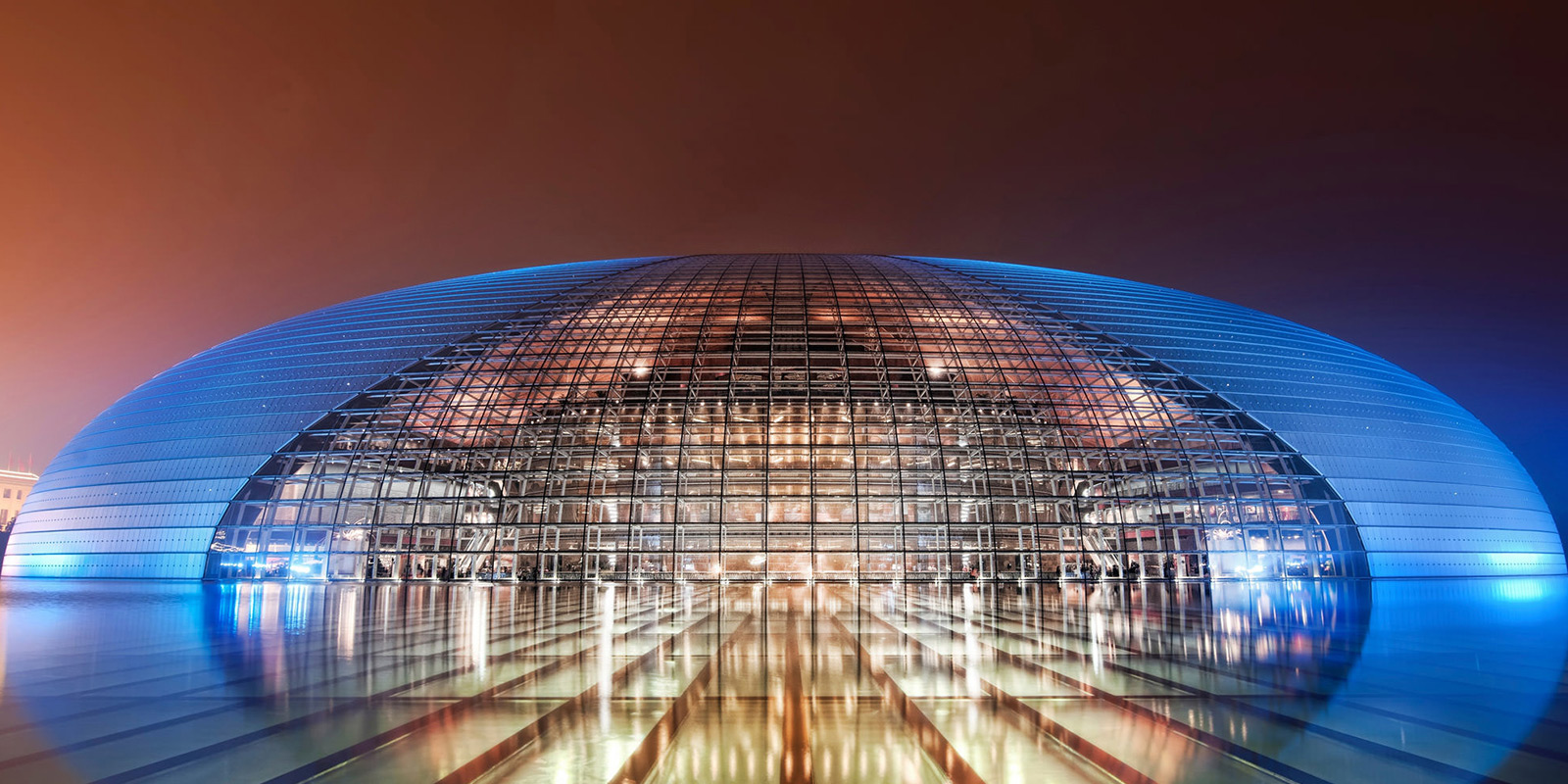National Centre for the Performing Arts, Beijing
Contents |
[edit] Introduction
The National Centre for the Performing Arts (NCPA) is located in the centre of Beijing, China. It is known by its nickname ‘the giant egg’, because of its distinctive flattened-dome shape.
The building is situated like an island in the middle of an artificial lake of 35,500 sq.m. Around the lake a green ring of 39,000 sq.m is intended to isolate the building from the noise of the city.
The NCPA was designed by French architect Paul Andreu, and houses an opera house capable of seating 2,398, a concert hall seating 2,019, a theatre seating 1,035, and a smaller multi-function theatre. Construction work began in 2001, and the inaugural concert was held in December 2007.
Its location provoked some controversy because of its proximity to Tiananmen Square, the Great Hall of the People and the Forbidden City. Andreu argued that, as an important international city, Beijing should include modern as well as ancient traditional Chinese architecture. The inclusion of the lake and the green ring were part of the design solution to complement the ancient architecture and prevent the contrast being too jarring.
[edit] Design and construction
The building is an ellipsoid dome of titanium and glass, designed to resemble an egg floating on water, or a water droplet. Andreu designed the building to be an iconic feature that would be instantly recognisable.
The dome has a maximum span of 213 m (in its east-west direction), a minimum span of 144 m (north-south), and reaches a height of 46 m. The total area of the building is 12,000 sq.m.
It is covered with 18,000 titanium plates, integrated with more than 1,000 sheets of ultra-white glass; a low-iron glass with high light transmission. The titanium shell is divided in two by a curved glass curtain, gradually widening from the top to the bottom where it measures 100 m in width. When illuminated at night this gives the impression of a stage curtain being pulled back, while during the day the glass curtain bathes the interior in light.
Visitors reach the building through the Underwater Corridor, a hallway that stretches beneath the lake from the green ring. The glass ceiling allows light to pass through from the water, producing a shimmering effect.
The large open foyer has a floor made of stone from 10 different regions in China. The interior walls are lined with tens of thousands of panels made of Brazilian rosewood.
[edit] Costs controversy
The building’s initial planned cost was 2.688 bn yuan. However, on completion, this had escalated to more than 3.2 bn yuan. It has been suggested it will be close-to impossible to recuperate the investment. Each individual seat, when averaged out, is worth around 500,000 yuan. On top of this, the huge costs of cleaning the external surface mean that the Chinese government faces subsidising the building for many years. Responding to this though, the Chinese government claimed that the building was never intended to be a for-profit venture.
[edit] Find out more
[edit] Related articles on Designing Buildings Wiki
- Apple Park.
- Beijing Greenland Center.
- Beijing National Stadium.
- Building of the week series.
- CCTV Headquarters.
- China Philharmonic Hall.
- City Hall, London.
- Forbidden City.
- Guggenheim Museum, Bilbao.
- Niteroi Contemporary Art Museum.
- Phoenix International Media Center, Beijing.
- Rose Museum.
- Royal Albert Hall.
- Sage Gateshead.
- Sydney Opera House.
- Types of dome.
- Unusual building design of the week.
- Xili Sports and Cultural Centre.
[edit] External resources
- Arcspace - National Centre for the Performing Arts
Featured articles and news
Homes England supports Greencore Homes
42 new build affordable sustainable homes in Oxfordshire.
Zero carbon social housing: unlocking brownfield potential
Seven ZEDpod strategies for brownfield housing success.
CIOB report; a blueprint for SDGs and the built environment
Pairing the Sustainable Development Goals with projects.
Types, tests, standards and fires relating to external cladding
Brief descriptions with an extensive list of fires for review.
Latest Build UK Building Safety Regime explainer published
Key elements in one short, now updated document.
UKGBC launch the UK Climate Resilience Roadmap
First guidance of its kind on direct climate impacts for the built environment and how it can adapt.
CLC Health, Safety and Wellbeing Strategy 2025
Launched by the Minister for Industry to look at fatalities on site, improving mental health and other issues.
One of the most impressive Victorian architects. Book review.
Common Assessment Standard now with building safety
New CAS update now includes mandatory building safety questions.
RTPI leader to become new CIOB Chief Executive Officer
Dr Victoria Hills MRTPI, FICE to take over after Caroline Gumble’s departure.
Social and affordable housing, a long term plan for delivery
The “Delivering a Decade of Renewal for Social and Affordable Housing” strategy sets out future path.
A change to adoptive architecture
Effects of global weather warming on architectural detailing, material choice and human interaction.
The proposed publicly owned and backed subsidiary of Homes England, to facilitate new homes.
How big is the problem and what can we do to mitigate the effects?
Overheating guidance and tools for building designers
A number of cool guides to help with the heat.
The UK's Modern Industrial Strategy: A 10 year plan
Previous consultation criticism, current key elements and general support with some persisting reservations.
Building Safety Regulator reforms
New roles, new staff and a new fast track service pave the way for a single construction regulator.
























